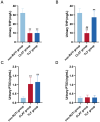The natural immune molecules urinary Tamm-Horsfall protein and pentraxin 3 as predictors for recurrent urinary tract infection severity: a single-center self-control study
- PMID: 39780518
- PMCID: PMC11721855
- DOI: 10.1080/0886022X.2024.2449574
The natural immune molecules urinary Tamm-Horsfall protein and pentraxin 3 as predictors for recurrent urinary tract infection severity: a single-center self-control study
Abstract
Objective: The innate immune defense plays a pivotal role in protecting the urinary tract from uropathogenic invasion and maintaining immune homeostasis. Dysregulation of the innate immune system can result in recurrent urinary tract infections (RUTI) due to heightened susceptibility to uropathogens. Despite this, predicting the risk of recurrence and the degree of immune compromise in patients who have had one urinary tract infection remains challenging. Also identifying which patients are more susceptible to developing pyelonephritis rather than the more local disease of cystitis is imperfect, although delayed diagnosis of a UTI is a good indicator for developing pyelonephritis. This study aims to assess the potential of urinary Tamm-Horsfall protein (THP) and Pentraxin 3 (PTX3) as predictors of RUTI symptom severity and recurrence, while also evaluating the efficacy of the Chinese herbal formulation Tailin Formula (TLF) as a clinical therapeutic intervention for RUTI.
Methods: A single-center cohort study was conducted involving 142 participants, consisting of 31 healthy individuals (non-RUTI group, n = 31) and 111 patients with RUTI. The RUTI patients were divided into two groups: one group received continuous low-dose antibiotic therapy (CLAT group, n = 55), and the other group received herbal preparations (Tailin formula) (TLF group, n = 56). All patients received consistent lifestyle guidance. Descriptive analysis was performed on the RUTI cohort.
Results: Urinary THP levels were significantly lower in RUTI patients (TLF and CLAT groups) compared to the non-RUTI, whereas PTX3 levels showed a tendency toward elevation. After treatment, urinary THP levels were markedly higher in the TLF group (27.43 ± 7.07) compared to pretreatment levels (10.00 ± 2.79), while levels remained lower in the CLAT group (8.91 ± 2.23) than in the TLF group. Urinary PTX3 levels decreased post-treatment in both groups after treatment than before (CLAT: 0.30 ± 0.13 vs. 1.04 ± 0.38; TLF: 0.29 ± 0.12 vs. 1.15 ± 0.36). Additionally, THP was negatively correlated with renal tubular injury markers NAG/Cr and β2-MG in RUTI patients (r = -0.5041 and -0.6169, respectively), while PTX3 showed a positive correlation with NAG/Cr and β2-MG (r = 0.28 and 0.498, respectively). Notably, as RUTI symptoms improved and recurrence rates decreased, urinary THP levels increased, while PTX3 levels decreased.
Conclusion: This study suggests that urinary THP and PTX3 are likely involved in the pathogenesis of RUTI. These biomarkers may serve as valuable predictors for assessing symptom severity, recurrence risk, and therapeutic efficacy in patients with RUTI at risk of disease progression.
Keywords: Recurrent urinary tract infection; Tamm–Horsfall protein; pentraxin 3; predictors; renal tubular injury.
Conflict of interest statement
All authors declare no competing interests regarding the publication of this manuscript.
Figures






Similar articles
-
Efficacy and safety of tailin formulation combined with continuous low-dose antibiotic therapy in patients with recurrent urinary tract infection: A multicenter, randomized, controlled clinical trial.Front Pharmacol. 2022 Sep 14;13:968980. doi: 10.3389/fphar.2022.968980. eCollection 2022. Front Pharmacol. 2022. PMID: 36188617 Free PMC article.
-
Clinical efficacy of Tailin formulation combined with continuous low-dose antimicrobial therapy for recurrent urinary tract infection: study protocol for a multicenter, double-blind, randomized, controlled clinical trial.Trials. 2021 Dec 11;22(1):901. doi: 10.1186/s13063-021-05830-4. Trials. 2021. PMID: 34895307 Free PMC article.
-
Uropathogenic Escherichia coli infection: innate immune disorder, bladder damage, and Tailin Fang II.Front Cell Infect Microbiol. 2024 Apr 4;14:1322119. doi: 10.3389/fcimb.2024.1322119. eCollection 2024. Front Cell Infect Microbiol. 2024. PMID: 38638825 Free PMC article.
-
The multiple functions of Tamm-Horsfall protein in human health and disease: a mystery clears up.Wien Klin Wochenschr. 2005 May;117(9-10):316-22. doi: 10.1007/s00508-005-0353-8. Wien Klin Wochenschr. 2005. PMID: 15989109 Review.
-
A Systematic Review of the (Un)known Host Immune Response Biomarkers for Predicting Recurrence of Urinary Tract Infection.Front Med (Lausanne). 2022 Jul 4;9:931717. doi: 10.3389/fmed.2022.931717. eCollection 2022. Front Med (Lausanne). 2022. PMID: 35860746 Free PMC article.
References
MeSH terms
Substances
LinkOut - more resources
Full Text Sources
Other Literature Sources
Medical
Miscellaneous
